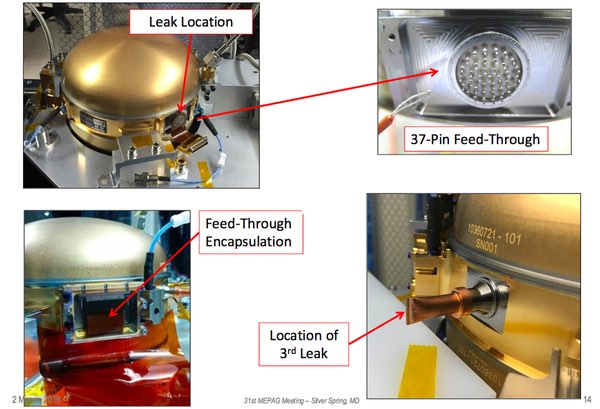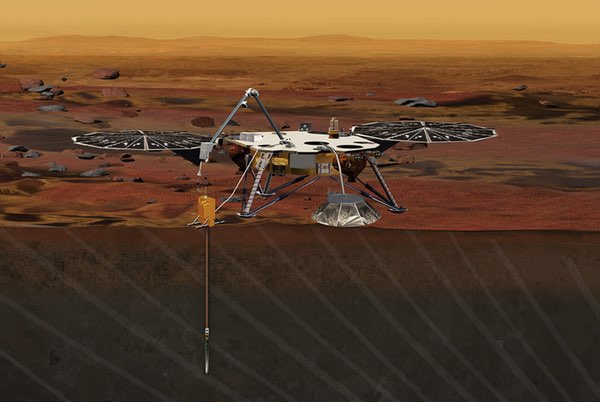InSight’s second chanceby Jeff Foust
|
| The fact that I’m standing up here in front of you and talking, instead of gloating on the phone from the central California coast, is a clue that things have not gone as well as one might have hoped,” said Banerdt. |
Instead, InSight is heading back to the Lockheed Martin factory in Colorado where it was assembled, to be put in storage. The spacecraft itself is in fine shape. The problem, though, was with one of its instruments, a seismometer provided by the French space agency CNES, whose development difficulties led NASA in December to cancel the planned launch this month.
“The fact that I’m standing up here in front of you and talking, instead of gloating on the phone from the central California coast, is a clue that things have not gone as well as one might have hoped,” said Bruce Banerdt, principal investigator for InSight, speaking at a meeting of NASA’s Mars Exploration Program Analysis Group (MEPAG) near Washington in early March, just before the InSight’s original launch window would have opened.
What doomed InSight’s launch was a persistent vacuum leak in that seismometer, known as the Seismic Experiment for Interior Structure (SEIS). “You might ask, ‘Why do you have a vacuum system on a seismometer?’” Banerdt said. That vacuum is necessary, he said, because of the extreme sensitivity of the instrument’s very broad band (VBB) sensor, which can detect displacements as small as one hundredth of a nanometer.
“We’re measuring pretty small things on the surface of Mars, and in order to do this, this beast here has to be operating in a pretty good vacuum,” he said. That vacuum, he added, has to be one hundredth of a millibar or better.
To achieve that vacuum, three VBB sensors are placed into a “quasi-spherical” container that looks a little bit like a small roaster or a similar cooking pan. “It’s about the size of your head,” he said. Several “feed-throughs” allow wires to get from the sensors inside the vacuum container to the outside. Those feed-throughs have caused Banerdt and others involved with InSight no end of headaches.
The first vacuum leak, he said, was detected in August and linked to a 37-pin electrical feed-though, and later localized to one of the pins. That was sealed and, by early October, had stopped the leak.
Days later, though, technicians found a second leak on another pin of the same feed-through, although only about one-tenth as strong as the first one. A sealing compound was used to stop the leak, as with the first one, only to have the leak resume days later after cycling the instrument through cold temperatures. By early November, that leak was resolved by encapsulating the entire feed-through.
Then, days after resolving the second leak, workers found a third one linked to the pinch off of an evacuation tube used to draw the vacuum. A new tube was welded to the sphere in early December. But, on December 20, a fourth leak was detected during another cold cycle test that was eventually traced back to the same feed-through that caused the initial leaks.
By that time, it was too late to fix the instrument in time for a March launch. “That was going to take us about three or four weeks beyond our launch, if everything went well, so that was not in the cards,” Banerdt said.
 A slide from Bruce Banerdt’s MEPAG presentation in early March shows the locations of the leaks in InSight’s SEIS instrument. (credit: NASA/JPL) |
The leak, he emphasized, was not particularly large, yet too big for the mission. “If your tire had a leak of this magnitude, you wouldn’t have to put any air in it for about three centuries,” he said. “It’s not very fast, but it’s too fast for us. We would actually come up to a pressure that was in excess of our requirement even before we ever got to the launch.”
With the 2016 launch cancelled, Banerdt and his team took time to develop a new plan for the mission, to see if the instrument leaks could be resolved and allow a future launch of the spacecraft, perhaps in the next window in 2018.
| “Whatever errors are made, are made with the complicity of all the partners,” Banerdt said. “It really was kind of a systemic problem.” |
“We very intensely studied the failure of this evacuated container. We know what went wrong. We know how to go about fixing it,” he said. That fix, he said, involves replacing the feed-throughs that turned out to be incompatible with the conditions the instrument will experience on Mars, something he blamed on an unnamed “second-tier subcontractor” involved with the instrument.
Banerdt, though, said the whole mission, and not just one subcontractor, should take responsibility for the leaky feed-through. “Whatever errors are made, are made with the complicity of all the partners,” he said. The overall management of the project, he said, “dropped the ball” in not catching this design flaw earlier in the instrument’s development. “It really was kind of a systemic problem.”
At the time of the MEPAG meeting, Banerdt had just briefed officials at NASA Headquarters about the revised plan. “That presentation went very well,” he concluded. “We had a lot of probing questions and a lot of difficult conversations, but overall we got a positive response.”
That revised plan would launch InSight, with the fixed SEIS instrument, in the next Mars launch opportunity, with a notional launch date of May 5, 2018 from Vandenberg. The spacecraft would land on Mars on November 26 of that year for a two-year primary mission. The landing site, a region called Elysium Planitia, would be the same as in the original mission plan.
A week later, Banerdt and the InSight team got the good news. NASA announced March 9 that it had agreed to that plan that would allow the mission to launch in May 2018. JPL will take over development of the vacuum container for SEIS, with CNES handling instrument integration and test activities. That division of labor, NASA said in the press release announcing the plan, is designed “to take advantage of each organization's proven strengths.”
The new plan, though, leaves open questions about how NASA will pay for the revised, delayed mission. In the press release, NASA said a cost estimate for the revised mission will not be available until August, once the space agency makes arrangements with United Launch Alliance about the new launch date.
However, Banerdt said in his MEPAG presentation that he estimated the revised mission will cost an additional $150 million or so, an amount that would be borne by NASA’s other planetary programs. “There’s less money to do something else,” he acknowledged. “Sorry about that.”
The likely source of that additional money would be the Discovery program of low-cost planetary science missions; NASA selected InSight in 2012 as the latest Discovery-class mission. The news comes as other teams perform studies of five mission concepts for the next Discovery selection, expected late this year. While NASA has hinted that it might select two of the five for full development, the additional cost of the InSight delays has raised fears that NASA might be able to afford only one.
John Grunsfeld, NASA’s associate administrator for science, said in an interview during the Goddard Memorial Symposium outside Washington, shortly after the agency announced its InSight plans, that NASA is not giving up on selecting two, despite InSight’s additional costs.
| “We will select at least one” new Discovery mission this December, said Green. “The delay in InSight hasn’t affected that selection.” |
Grunsfeld suggested that good financial performance on other NASA science missions have created budget reserves that can help cover part of the cost of the InSight plan. “The actual impact is probably less than half of that $140–150 million,” he said. Grunsfeld said that, in that case, NASA could still select two Discovery missions later this year, but delay the start of the second one by six to twelve months.
At a “NASA Night” presentation last week at the Lunar and Planetary Science Conference near Houston, agency officials remained open to selecting two Discovery missions this year. “We will select at least one,” said Jim Green, director of NASA’s planetary science division, adding he will “push the envelope” about selecting a second. “The delay in InSight hasn’t affected that selection.”
At the MEPAG meeting, one attendee asked if CNES, whose instrument caused the delay, will contribute any money. “They won’t be giving us any money to do the things that we need to do, and that’s because of the way international collaborations work,” Banerdt said. “No money changes hands. We’re partners: the French spend the money on their stuff, and we spend the money on our stuff.”
He argued that CNES would be spending plenty of money on InSight in the coming year as they worked with JPL on fixing the instrument. “They probably will have more people working on the project in the next year than we will here in the United States, because they’re doing the bulk of the work on the seismometer,” he said.
Despite the InSight delay, Mars scientists at the MEPAG meeting were cautiously optimistic about the future of NASA’s Mars exploration programs. Several spacecraft, both on the surface and in orbit, are operating in good condition there now. Besides InSight, work is proceeding well on the Mars 2020 rover, the first step in a multi-mission Mars sample return effort. The rover recently passed its preliminary design review, said Jim Watzin, head of NASA’s Mars Exploration Program.
Planning is also in the earliest stages for a proposed 2022 mission, likely an orbiter that can take over the telecommunications and reconnaissance roles of existing spacecraft that will be nearing the ends of their lives by the early 2020s. That orbiter could also play a role in the sample return effort, particularly if it uses solar electric propulsion, Watzin said.
“Overall, I’ll say the program is good,” he said, offering his overall assessment of NASA’s Mars robotic exploration efforts. “It’s relatively healthy, with lots of things happening and continuing to happen, and lots of things are in the planning stage.”
